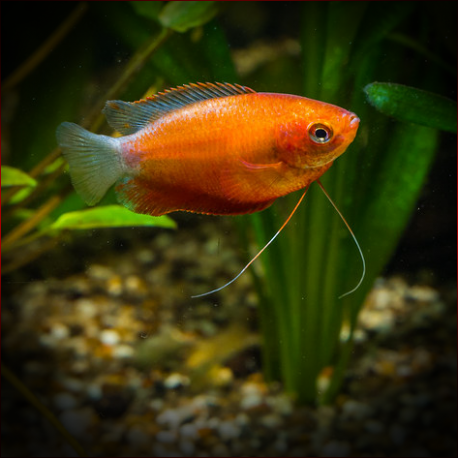More info
Datasheet
| Minimum Tank Size | 71 litres / 18.76 US gallons |
| Maximum Size | 10.2cm / 4.02inches |
| Temperature | 22°C / 71.60°F - 27°C / 80.60°F |
| Hardness | 5-15ºdH |
| pH | 6.0-7.5 |
General Description
The Thick-Lipped Gourami (Trichogaster Labiosa) is a peaceful species known for its ease of keeping in a community tank setting. It possesses an accessory breathing organ called the labyrinth organ, allowing it to breathe atmospheric air to a certain extent. Selectively bred strains, such as the gold or 'sunset' variation, exhibit vibrant colorations. This species is commonly imported into the aquarium trade.
Aquarium Setup
For optimal health, house the Thick-Lipped Gourami in a well-planted aquarium with a dark substrate to mimic its natural habitat. Providing ample cover through plants and floating vegetation is crucial, as this species tends to be shy and slow-moving. Minimize water flow from filters to ensure a comfortable environment for the gourami.
Behaviour
Renowned for its compatibility in community tanks, the Thick-Lipped Gourami thrives alongside peaceful tankmates like danios, rasboras, loaches, and other anabantoids. It is not advised to keep them with closely-related species like the banded or giant gourami, as hybridization can occur.
Feeding and Diet
This gourami species has an undemanding diet, readily accepting a variety of foods. It particularly enjoys small live and frozen options like bloodworms and daphnia. Offering a diverse diet ensures the gourami receives essential nutrients for its overall health.
Reproduction & Dimorphism
As a bubble nest builder, the Thick-Lipped Gourami requires a separate tank for spawning, featuring shallow water with floating plants and cover for the female. During courtship, the male intensifies in coloration and builds a bubble nest for the spawning process. After spawning, the male guards and tends to the brood until they are free-swimming fry.
Habitat and Distribution
In the wild, the Thick-Lipped Gourami is found in shady, slow-moving rivers and ponds, typically in weedy areas abundant with floating vegetation. Its distribution is limited to Southern Myanmar, where it thrives in oxygen-deprived conditions.

